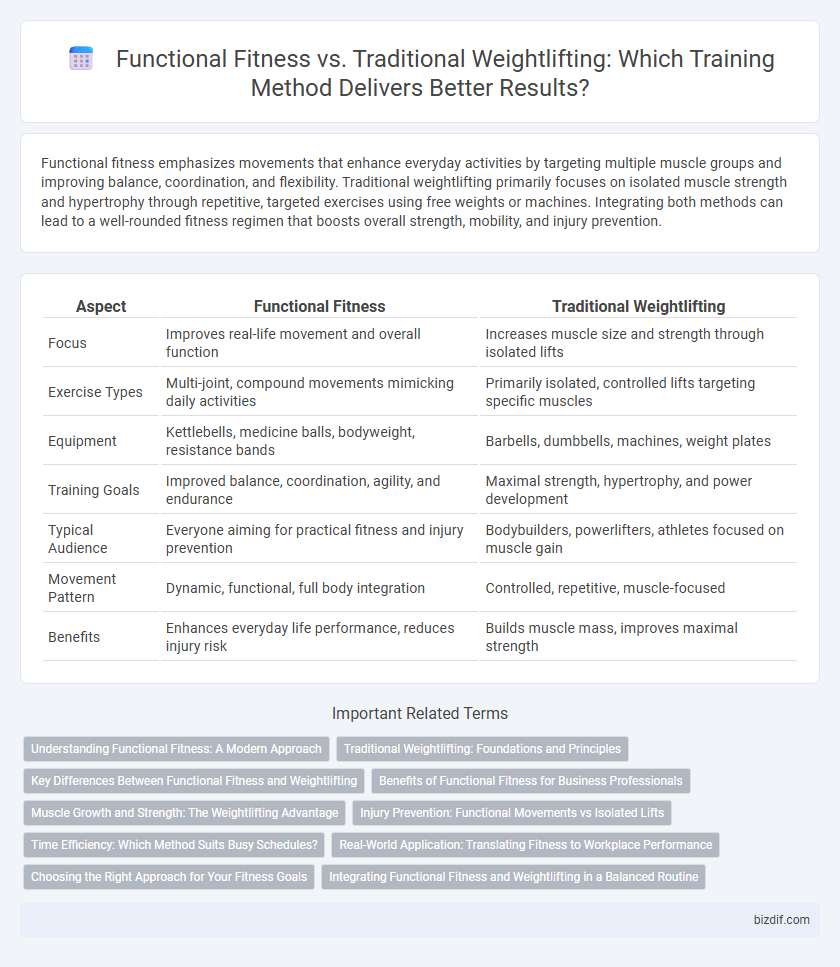Functional fitness emphasizes movements that enhance everyday activities by targeting multiple muscle groups and improving balance, coordination, and flexibility. Traditional weightlifting primarily focuses on isolated muscle strength and hypertrophy through repetitive, targeted exercises using free weights or machines. Integrating both methods can lead to a well-rounded fitness regimen that boosts overall strength, mobility, and injury prevention.
Table of Comparison
| Aspect | Functional Fitness | Traditional Weightlifting |
|---|---|---|
| Focus | Improves real-life movement and overall function | Increases muscle size and strength through isolated lifts |
| Exercise Types | Multi-joint, compound movements mimicking daily activities | Primarily isolated, controlled lifts targeting specific muscles |
| Equipment | Kettlebells, medicine balls, bodyweight, resistance bands | Barbells, dumbbells, machines, weight plates |
| Training Goals | Improved balance, coordination, agility, and endurance | Maximal strength, hypertrophy, and power development |
| Typical Audience | Everyone aiming for practical fitness and injury prevention | Bodybuilders, powerlifters, athletes focused on muscle gain |
| Movement Pattern | Dynamic, functional, full body integration | Controlled, repetitive, muscle-focused |
| Benefits | Enhances everyday life performance, reduces injury risk | Builds muscle mass, improves maximal strength |
Understanding Functional Fitness: A Modern Approach
Functional fitness emphasizes exercises that mimic real-life movements, enhancing overall body coordination, balance, and strength essential for daily activities. Unlike traditional weightlifting, which often isolates muscle groups, functional training engages multiple muscle groups simultaneously to improve practical performance and injury prevention. This modern approach integrates dynamic, multi-planar movements designed to boost flexibility, endurance, and agility in varied environments.
Traditional Weightlifting: Foundations and Principles
Traditional weightlifting focuses on building muscle strength and hypertrophy through structured exercises like squats, deadlifts, and bench presses, emphasizing progressive overload and proper form. It prioritizes isolated muscle group development and controlled movement patterns to maximize strength gains and muscular endurance. Core principles include consistent training volume, periodization, and sufficient recovery to optimize performance and reduce injury risk.
Key Differences Between Functional Fitness and Weightlifting
Functional fitness emphasizes multi-joint, dynamic movements that mimic real-life activities, improving overall mobility, balance, and coordination. Traditional weightlifting targets isolated muscle groups with fixed patterns, focusing primarily on strength and hypertrophy. Functional fitness integrates stability and agility training, whereas traditional weightlifting prioritizes maximal force production and progressive overload.
Benefits of Functional Fitness for Business Professionals
Functional fitness enhances core strength, balance, and flexibility, improving overall workplace performance and reducing injury risk from prolonged sitting. It trains multiple muscle groups in natural movement patterns, boosting energy levels and productivity during demanding workdays. Business professionals gain increased mobility and mental clarity, supporting better focus and stress management throughout their busy schedules.
Muscle Growth and Strength: The Weightlifting Advantage
Traditional weightlifting emphasizes targeted muscle hypertrophy and maximal strength gains through isolated, high-load exercises like squats, deadlifts, and bench presses, which effectively stimulate muscle fibers for growth. Functional fitness, while enhancing overall movement efficiency and injury prevention, typically involves dynamic, full-body movements that prioritize coordination and endurance over isolated muscle growth. For individuals aiming primarily at muscle size and maximal strength, conventional weightlifting provides a superior training stimulus and measurable progress in hypertrophy.
Injury Prevention: Functional Movements vs Isolated Lifts
Functional fitness emphasizes multi-joint, dynamic movements that mimic real-life activities, enhancing overall joint stability and muscle coordination, which significantly reduces injury risk. Traditional weightlifting often involves isolated lifts targeting specific muscles, potentially leading to imbalances and higher susceptibility to strains or overuse injuries. Incorporating functional movements like squats, lunges, and kettlebell swings promotes balanced muscle development and improved proprioception critical for injury prevention.
Time Efficiency: Which Method Suits Busy Schedules?
Functional fitness maximizes time efficiency by combining strength, balance, and flexibility in compound movements that mimic real-life activities, making workouts effective in shorter durations. Traditional weightlifting often requires isolated sets and rest periods, extending total workout time but targeting specific muscle groups for hypertrophy. Busy schedules benefit more from functional fitness routines, which deliver comprehensive results within 20-30 minutes.
Real-World Application: Translating Fitness to Workplace Performance
Functional fitness emphasizes multi-joint movements and core stability that mimic everyday tasks, enhancing workplace performance by improving balance, coordination, and injury prevention. Traditional weightlifting primarily targets isolated muscle groups, which builds strength but may lack direct application to occupational demands. Integrating functional fitness into training routines leads to greater real-world benefits such as enhanced endurance and posture during prolonged periods of standing or manual labor.
Choosing the Right Approach for Your Fitness Goals
Functional fitness emphasizes multi-joint, dynamic movements that mimic real-life activities, improving overall mobility, balance, and coordination. Traditional weightlifting focuses on isolated muscle groups with controlled, repetitive exercises to build strength and muscle mass. Selecting the right approach depends on individual fitness goals--functional training suits those aiming for practical strength and injury prevention, while traditional weightlifting benefits those targeting muscular hypertrophy and maximal strength gains.
Integrating Functional Fitness and Weightlifting in a Balanced Routine
Integrating functional fitness and traditional weightlifting creates a balanced routine that enhances overall strength, flexibility, and movement efficiency. Functional fitness exercises target multiple muscle groups and mimic real-life movements, improving coordination and reducing injury risk, while weightlifting focuses on building muscle mass and increasing raw strength through controlled, isolated lifts. Combining both approaches optimizes athletic performance and daily functionality by promoting muscular balance and dynamic power.
Functional Fitness vs Traditional Weightlifting Infographic

 bizdif.com
bizdif.com